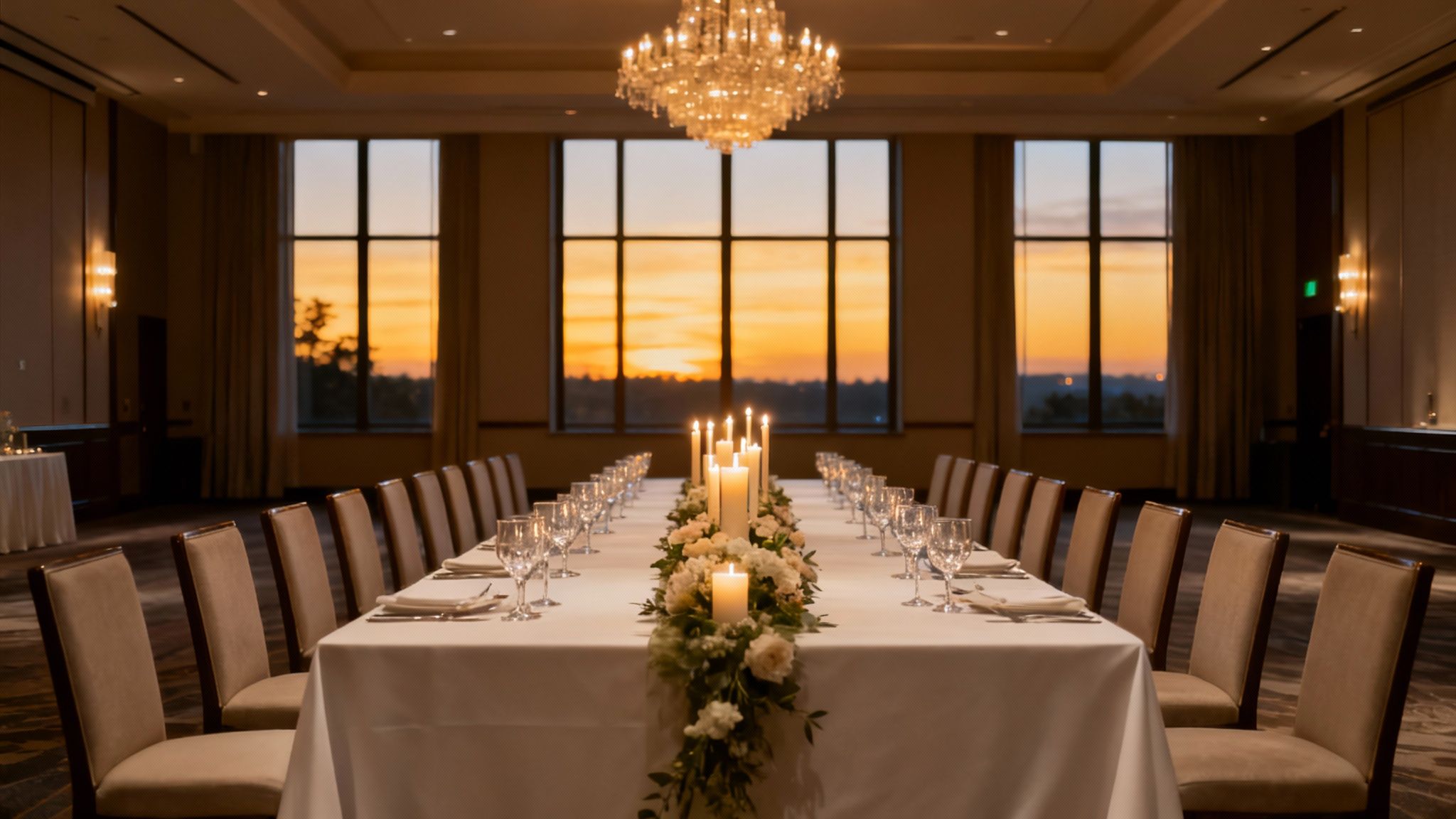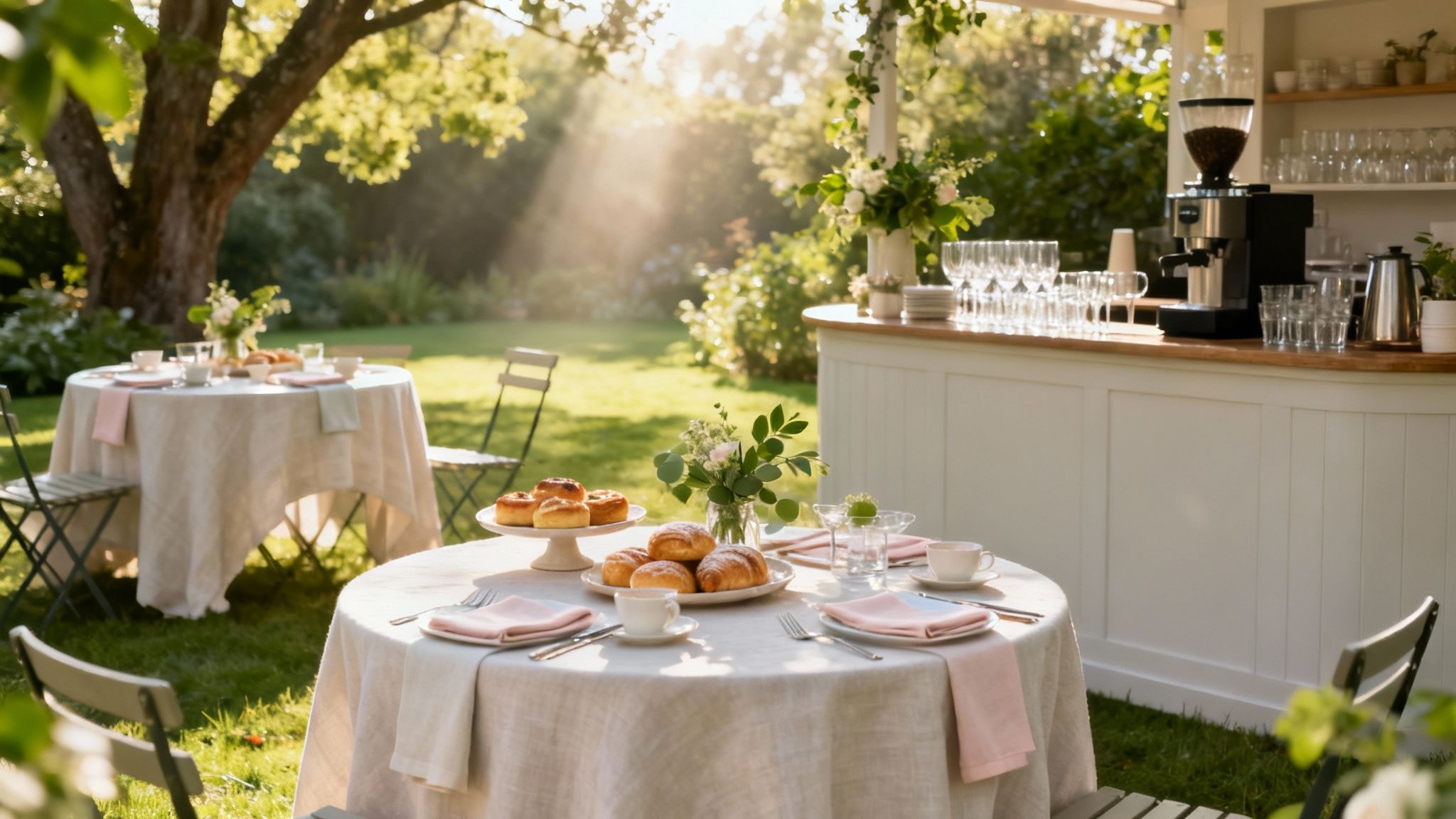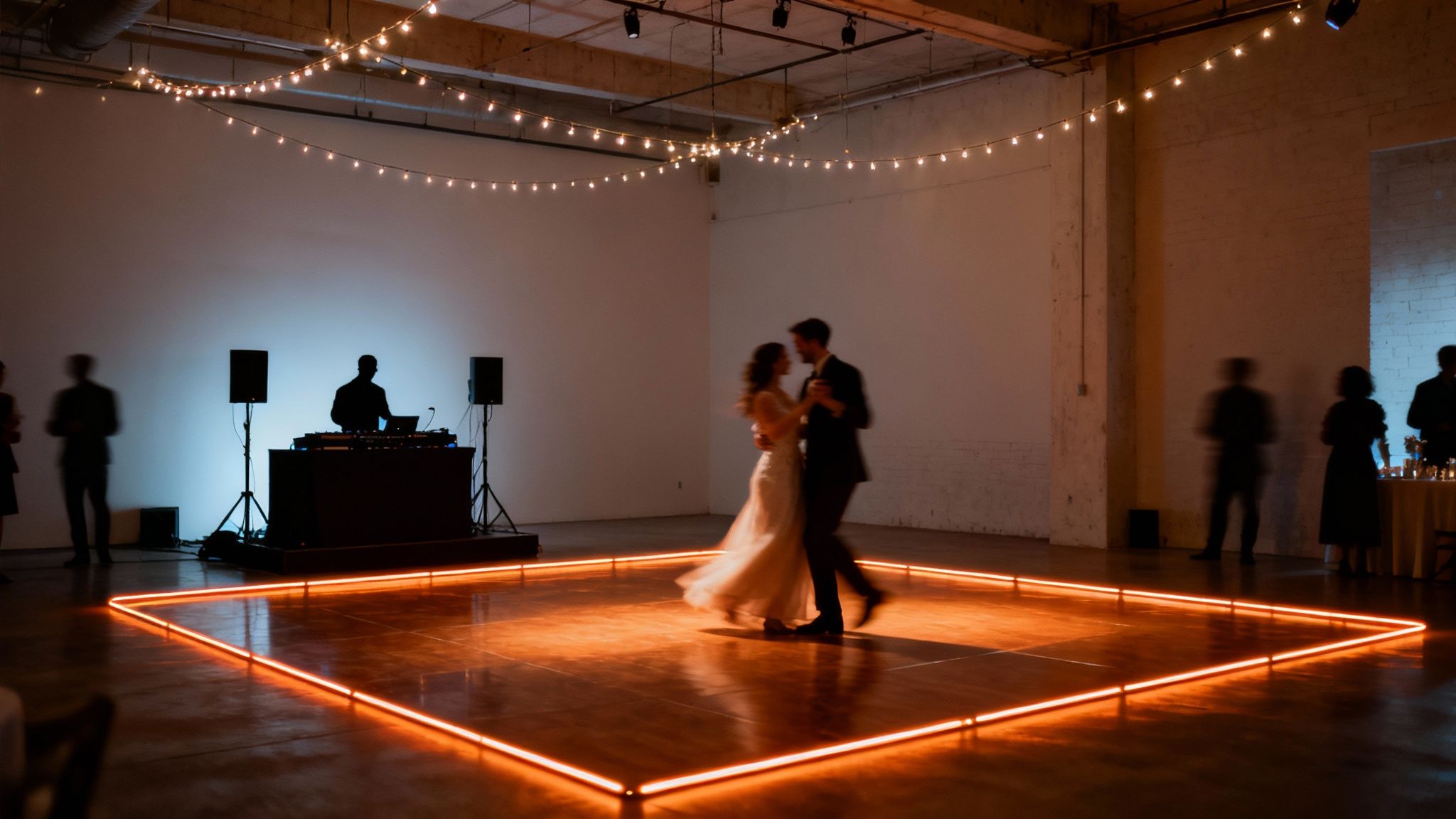Planning a wedding can feel like conducting an orchestra—every vendor, every moment, and every guest needs to hit their cue perfectly. The secret to a flawless performance? A killer timeline. A well-structured schedule is the difference between a day of chaotic scrambling and one of blissful, seamless celebration. But not all weddings are the same, and a one-size-fits-all template just won't cut it. Your timeline is the invisible thread that ties everything together, ensuring your photographer captures the golden hour, your caterer serves dinner hot, and your guests hit the dance floor right on schedule.
That's why we’ve curated a deep dive into 8 detailed wedding day timeline examples, each designed for a different style, vibe, and vision. We’re moving beyond simple checklists to give you a strategic blueprint you can actually use. From a traditional evening affair to a trendy brunch celebration or even a multi-day festival, this guide provides downloadable templates, insider tips from pros, and the strategic insights you need to build a flawless schedule. We'll break down the 'why' behind each timeline's structure, offering actionable takeaways so you can stop stressing and start celebrating.
Think of this as your master plan. While the schedule dictates the flow, other crucial elements contribute to the wedding aesthetic. For instance, deciding when the groom and groomsmen should get ready also ties into choosing the best wedding suit color combinations to ensure they complement the day's lighting and overall theme. Every detail matters, and it all starts with a solid plan. Let's get started.
1. The Traditional Formal Evening Timeline
If you dream of a classic, elegant affair, the traditional formal evening timeline is your gold standard. This popular schedule creates a seamless, sophisticated flow, starting with preparations in the early afternoon and leading into a late afternoon or early evening ceremony. The grand finale is a full-scale dinner reception that parties into the night. It's the go-to structure for everything from lavish hotel ballroom weddings to upscale country club celebrations.
This timeline's major advantage is its pacing. It gives you and your wedding party ample, relaxed time to get ready without a frantic morning rush. Guests also appreciate the later start, as it allows them to handle daytime commitments before heading to your ceremony. This structure is one of the most popular wedding day timeline examples for a reason: it’s polished, time-tested, and focuses on creating a high-end guest experience.

Strategic Breakdown & Actionable Tips
This timeline hinges on meticulous planning, especially when coordinating multiple vendors for a formal event.
- Prep Time is Non-Negotiable: Schedule hair and makeup to begin at least 5-6 hours before the ceremony. For a 5:00 PM ceremony, that means a 11:00 AM or 12:00 PM start. This buffer is crucial for touch-ups and prevents feeling rushed.
- Embrace the First Look: Plan your first look photos 1 to 1.5 hours before the ceremony. This emotionally resonant moment also allows you to complete most bridal party and family portraits beforehand, letting you join your cocktail hour sooner.
- Master Golden Hour: The hour just before sunset provides the most flattering, romantic light for photos. Work backward from the sunset time on your wedding day and schedule your newlywed portraits with your photographer to coincide with this magical window.
- Vendor Coordination: Ensure your DJ or band is set up and ready for sound checks before the first guest arrives for the cocktail hour. If you're using special effects like a fog machine for your first dance or uplighting, confirm the setup and testing times with your vendor, which often happens during the dinner service. For a deeper dive into the reception schedule, check out these tips for crafting your perfect wedding reception timeline.
2. The Modern Morning Brunch Timeline
For couples who love bright, natural light and a more relaxed, contemporary vibe, the modern morning brunch timeline is a fantastic choice. This schedule flips the traditional model on its head, featuring an early ceremony between 9:00 AM and 11:00 AM, immediately followed by a chic brunch reception. It’s perfect for garden parties, modern city loft weddings, or sunny beachside celebrations, offering a refreshing and often more budget-friendly alternative to a formal evening affair.
The primary advantage of this timeline is its laid-back elegance and unique guest experience. You get to celebrate during the best part of the day and then have the entire afternoon and evening to yourselves as newlyweds. This format is one of the more unique wedding day timeline examples, appealing to Millennial and Gen-Z couples who want to break from tradition and create a memorable, lighthearted event that feels authentically them.

Strategic Breakdown & Actionable Tips
An early start requires precise coordination, but the payoff is a wonderfully relaxed celebration.
- Early Glam Session: Hair and makeup must start very early. For a 10:00 AM ceremony, your artists should begin around 6:00 AM or 7:00 AM. This allows about 2-3 hours for preparations without feeling frantic.
- A Swift First Look: A first look is still a great idea, but it can be more concise. Schedule a 30 to 45-minute session for photos just before the ceremony. This captures the intimate moment while keeping the morning schedule tight and efficient.
- Focus on Daytime Delights: Make the brunch theme central to your reception. Feature an amazing coffee bar, a mimosa or bloody mary station, and a menu of elevated brunch classics. Music should match the mood; consider the vibe you want for your morning wedding ceremony music playlist.
- Rethink the Grand Exit: Instead of a late-night sparkler exit, plan a mid-afternoon send-off. A bubble or petal toss as you leave the brunch reception around 2:00 PM creates a beautiful photo opportunity and a definitive end to the formal celebration.
3. The Afternoon Tea Reception Timeline
For couples seeking a refined, daytime celebration with a touch of European elegance, the Afternoon Tea Reception Timeline offers a charming and unique alternative. This sophisticated schedule typically features a mid-afternoon ceremony, around 2:00 or 3:00 PM, followed immediately by a classic tea service. It swaps the traditional dance floor for delightful conversation, tiered platters of treats, and a relaxed, sunlit atmosphere, perfect for garden parties or historic estate venues.
The primary advantage of this timeline is its distinctiveness and civilized pace. It provides a highly stylized experience that feels both special and intimate, avoiding the late-night party fatigue some guests experience. This format is ideal for couples who prefer meaningful conversation over a loud dance party and want to create a memorable, picture-perfect event. As one of the more unique wedding day timeline examples, it’s a nod to British tradition, popularized by royal weddings and upscale destination planners.
Strategic Breakdown & Actionable Tips
This timeline’s success lies in managing guest expectations and curating the perfect elegant atmosphere.
- Set Expectations Early: Your invitations are key. Clearly state "Afternoon Tea Reception to follow" so guests understand the format. This prevents them from expecting a full dinner and dance party, ensuring everyone arrives ready to enjoy the specific experience you've planned.
- Substantial Bites are a Must: While delicate pastries are essential, don't skimp on savory options. Offer a generous variety of tea sandwiches, mini quiches, scones with clotted cream, and other hearty bites to ensure guests feel satisfied. This is a meal, not just a snack.
- Plan for Perfect Lighting: A 2:00 PM ceremony allows you to capture portraits in the beautiful "golden hour" light later in the afternoon. Schedule your newlywed photos around 4:30 or 5:00 PM, while guests are mingling and enjoying the final course of desserts.
- Curate the Ambiance: The right entertainment is crucial. A live string quartet or a classical pianist will elevate the atmosphere far more effectively than a DJ. For engaging guests beyond conversation, consider low-key reception activities like lawn games or a live painter. For more ideas, explore these creative wedding reception activities that complement a tea service perfectly.
4. The Late Night Celebration Timeline
For couples who come alive after dark, the late-night celebration timeline flips the traditional wedding schedule on its head. This unconventional format is built for night owls, featuring a ceremony that doesn't start until 7:00 PM or 8:00 PM and a reception that keeps the party going until 1:00 AM or later. It’s perfect for creating an energetic, club-like atmosphere in a downtown loft, a sleek urban nightclub, or any venue that thrives on evening energy.
This timeline's greatest asset is its focus on an uninterrupted, high-energy party. By starting late, you cater to a crowd that loves to dance and celebrate into the early morning hours. Guests have their entire day free, arriving ready for an epic evening. This is one of the more modern wedding day timeline examples, ideal for couples who want their wedding to feel less like a formal dinner and more like the best party they've ever thrown.

Strategic Breakdown & Actionable Tips
Sustaining energy and ensuring guest comfort are the keys to a successful late-night event.
- Fuel the Party: A standard dinner service won't cut it. Plan for substantial food offerings throughout the event. Consider a heavy cocktail hour before the ceremony, followed by food stations that open after the formalities, and a late-night snack bar around 11:00 PM with items like sliders or tacos.
- Pace the Entertainment: Work closely with your DJ to build the energy progressively. Schedule high-energy moments, like a contemporary Jewish hora or other group dances, for peak dancing hours (e.g., 10:30 PM – 12:00 AM). The music is central, so it's vital to create a timeline that keeps the dance floor packed; get a closer look at structuring the music with these insights on your wedding DJ's timeline.
- Lighting is Everything: To create a true party vibe, invest in professional lighting. Uplighting, intelligent dance floor lights, and even a custom gobo can transform a space and signal that this is a celebration, not a quiet dinner.
- Prioritize Guest Safety: With a party running late, logistics are critical. Arrange for shuttle services or provide guests with codes for ride-sharing apps to ensure everyone gets home safely. Also, work with your bartending service to monitor alcohol consumption responsibly throughout the long evening.
5. The Split Celebration Timeline
For couples looking to break the mold, the split celebration timeline offers an innovative and highly flexible approach. This modern schedule divides your wedding into two distinct parts: an intimate ceremony, often followed by light refreshments or a luncheon, and a separate, full-scale reception held hours later or even on a different day. It’s a perfect solution for multi-cultural weddings blending different traditions, destination events where guests have other activities, or for couples who simply want a relaxed break in their day.
The primary advantage of this timeline is the freedom it provides. It allows for a deeply personal and private ceremony, followed by a high-energy party atmosphere later without the fatigue of a marathon day. Guests love the flexibility, too, as it can accommodate travel schedules, childcare needs, or even just the desire for a mid-day nap before the evening festivities. Among wedding day timeline examples, this one is gaining traction for its guest-centric and customizable nature.
Strategic Breakdown & Actionable Tips
A split timeline requires crystal-clear communication and logistical precision to ensure a smooth experience for everyone involved.
- Communicate with Clarity: Your invitations and wedding website are critical. Clearly state the times and locations for both the ceremony and the reception. Use phrases like "Ceremony & Luncheon" and "Evening Reception & Celebration" to avoid any confusion. An online RSVP that allows guests to confirm attendance for each part separately is a must.
- Bridge the Gap Thoughtfully: The time between events, often called "the gap," needs careful planning. Provide guests with a curated list of local cafes, attractions, or hotel lounges where they can relax. For destination weddings, this is the perfect window for a group excursion or free time to explore.
- Plan a "Second First Look": Use the break for a wardrobe change! This creates a wow moment for the reception entrance and allows for a second, completely different photo session. A daytime ceremony look can be classic and elegant, while the evening reception look can be more glamorous and party-ready.
- Logistics are Everything: Consider transportation between the ceremony and reception venues, especially if many guests are from out of town. Arranging a shuttle service is a thoughtful touch that prevents logistical headaches. Ensure your vendor team is fully briefed on the two-part schedule, including separate setup times for your DJ, caterer, and any special effects like a photo booth, which should be ready when reception doors open.
6. The Day-After Celebration Timeline
Breaking from the single-day whirlwind, the day-after celebration timeline is a modern, relaxed approach that spreads the festivities over two days. This structure typically involves an intimate, formal ceremony on a Friday or even a Thursday, followed by a larger, more casual celebration like a brunch, luncheon, or lively barbecue the next day. It’s a fantastic way to maximize time with loved ones, especially for destination weddings or when integrating cultural traditions, such as some Jewish weddings that separate the ceremony from the main reception.
The primary benefit of this timeline is the significant reduction in stress. By splitting the legal and emotional weight of the ceremony from the high-energy party, couples get to be more present and enjoy each component fully. Guests also benefit from a more relaxed pace, turning a one-night event into a memorable mini-vacation. This is one of the more unique wedding day timeline examples, perfect for couples who want to ditch the pressure and focus on quality time.
Strategic Breakdown & Actionable Tips
Successfully executing a two-day event requires clear communication and a focus on guest comfort and logistics.
- Set the Tone for Day Two: Ensure the second day’s celebration is distinctly more casual and low-pressure. Think food trucks, lawn games, or a relaxed brunch vibe. This contrast makes each event feel special and prevents guest fatigue.
- Communicate Clearly and Often: Use your wedding website, invitations, and welcome bags to clearly outline the schedule for both days. Provide details on dress codes, locations, and transportation to avoid any confusion.
- Coordinate Guest Logistics: If events are at different venues, arranging group transportation is a must. Consider a central hotel block to make logistics easier for out-of-town guests and to foster a communal, celebratory atmosphere throughout the weekend.
- Schedule High-Energy Elements for Day Two: Since the formal ceremony is complete, Day 2 is perfect for the main party. This is the time for your high-energy band or DJ, the photo booth, and the packed dance floor. Your photographer and videographer should be booked to capture this celebration, focusing on candid moments and guest interactions. You can learn more about structuring your reception’s key moments by exploring these ideas for a fun and unique wedding reception.
7. The Weekend Wedding Festival Timeline
For couples who believe one day is simply not enough, the weekend wedding festival timeline transforms a single event into an unforgettable multi-day experience. This luxury approach extends the celebration over a long weekend, often from Thursday to Sunday, creating an immersive retreat for you and your guests. It’s perfect for destination weddings, multi-cultural celebrations, or any couple wanting to maximize quality time with loved ones who have traveled to be there. Think welcome cocktail parties, rehearsal dinners, the main event, and farewell brunches all rolled into one epic itinerary.
The primary benefit of this timeline is the unparalleled guest experience it creates. Instead of a few rushed hours, guests enjoy a mini-vacation centered around your nuptials, allowing for deeper connections and more relaxed, memorable moments. This format is a signature of high-end destination weddings in places like Italy or Mexico, where the location itself is part of the celebration. Among the various wedding day timeline examples, this one offers the most expansive and immersive experience, turning your wedding into a landmark event for everyone involved.
Strategic Breakdown & Actionable Tips
Coordinating a multi-day event requires next-level organization, essentially planning three to four distinct events back-to-back.
- Communicate with an Itinerary: A detailed itinerary is non-negotiable. Use a wedding website or app for real-time updates, and provide a physical copy in guest welcome bags. Include times, locations, dress codes, and transportation details for every single event.
- Hire a Weekend Coordinator: This is not a job for a day-of coordinator. You need a dedicated planner or team experienced in managing multi-day events, guest logistics, and multiple vendor teams across different venues.
- Plan Varied Activities: Prevent guest burnout by offering a mix of structured and free-time activities. A welcome barbecue is a great casual start, the wedding day is the formal peak, and a relaxed farewell brunch provides a gentle wind-down. Consider optional activities like a group tour, pool time, or a golf outing.
- Create a Comprehensive Media Plan: Your photography and videography coverage must be planned for the entire weekend. Decide which events are "must-capture" (welcome party, rehearsal, wedding day) and which are optional. Brief your media team on key people and moments to look for at each distinct event to ensure a cohesive story of the entire celebration.
8. The Intimate Micro-Wedding Timeline
Perfect for couples who value deep connection over grand spectacle, the micro-wedding timeline is built for intimacy and efficiency. This condensed schedule typically spans 3-4 hours and accommodates a small guest list, usually between 25 and 50 people. The focus is on quality time, stripping away the formalities of a large-scale event to create a relaxed, personal celebration.
This timeline's greatest strength is its flexibility and focus on what truly matters: the couple and their closest loved ones. It’s a popular choice for backyard celebrations, private restaurant buyouts, and elopements followed by a small family gathering. As one of the most personal wedding day timeline examples, it allows for a more meaningful, less stressful experience by combining the ceremony and a casual reception into one seamless, heartfelt event.
Strategic Breakdown & Actionable Tips
A micro-wedding eliminates many logistical headaches, but thoughtful planning is still key to making the short timeframe feel special and complete.
- Combine and Conquer: Host your ceremony and reception in the same location to maximize your time. A beautiful park pavilion, a chic private dining room, or a lush backyard can serve as the perfect all-in-one venue. This removes travel time and keeps the intimate atmosphere intact. If you need some inspiration, you can find more unique options in our guide to small event space ideas.
- Prioritize Meaningful Moments: With fewer formalities, you can focus on personal details. Instead of a garter toss, consider a group toast where each guest shares a memory. A simple but high-quality menu often feels more special than a standard multi-course banquet.
- Keep Photography Efficient: With a smaller group, you don't need hours for portraits. Schedule a 30-45 minute window immediately following the short ceremony to capture shots with every guest, followed by newlywed photos. This ensures everyone feels included without a long, awkward wait.
- Set a Casual Tone: A relaxed dress code can help guests feel more comfortable and enhance the intimate vibe. Inform guests that the event is more of a celebratory dinner party than a formal reception, which helps manage expectations and reduces pressure for everyone involved.
8 Wedding Day Timeline Comparisons
| Timeline | Implementation Complexity 🔄 | Resource Requirements ⚡ | Expected Outcomes 📊⭐ | Ideal Use Cases 💡 | Key Advantages ⭐ |
|---|---|---|---|---|---|
| The Traditional Formal Evening Timeline | Medium — requires long prep window and lighting transitions 🔄🔄 | High — venue, full catering, lighting, extended staff ⚡⚡ | Elegant formal reception; strong golden-hour photos; 6–8 hrs 📊 ⭐⭐⭐ | Formal ballroom/estate weddings; guests traveling from afar 💡 | Elegant ambiance; great photo windows; guest convenience; widely understood ⭐ |
| The Modern Morning Brunch Timeline | Low — straightforward daytime flow 🔄 | Low — simpler menu, shorter vendor hours ⚡ | Casual, bright aesthetic; cost savings; 4–5 hrs 📊 ⭐⭐ | Garden, beach, city lofts; family-friendly and time-sensitive guests 💡 | Lower cost; excellent natural light; shorter day; family-friendly ⭐ |
| The Afternoon Tea Reception Timeline | Low–Medium — focused service timing and presentation 🔄🔄 | Low–Medium — light catering, music/ambiance ⚡⚡ | Refined, intimate mid-day event; limited dancing; 3–4 hrs 📊 ⭐⭐ | Tea/heritage-inspired events; older guest base; historic venues 💡 | Unique elegance; cost-effective vs dinner; excellent daylight photography ⭐ |
| The Late Night Celebration Timeline | Medium–High — late logistics, nightlife production 🔄🔄🔄 | High — extended hours, sound/lighting, security ⚡⚡⚡ | High-energy party atmosphere; extended dancing; 6–8+ hrs 📊 ⭐⭐⭐ | Urban lofts, nightclubs, younger guest demographics 💡 | Maximum entertainment time; lively atmosphere; nightlife-friendly ⭐ |
| The Split Celebration Timeline | High — two distinct setups and tight coordination 🔄🔄🔄 | Medium–High — two service periods, possible shuttle needs ⚡⚡ | Flexible attendance; can feel fragmented if poorly managed 📊 ⭐⭐ | Destination brides/grooms; guests with evening commitments; multi-time-zone events 💡 | Guest flexibility; capacity cost savings; two distinct vibes ⭐ |
| The Day-After Celebration Timeline | High — multi-day coordination and vendor scheduling 🔄🔄 | High — venues/catering across two days ⚡⚡⚡ | Relaxed multi-day experience; extended storytelling and coverage 📊 ⭐⭐⭐ | Destination weekends; cultural/religious multi-day traditions 💡 | Reduces single-day stress; extended guest interaction; varied programming ⭐ |
| The Weekend Wedding Festival Timeline | Very High — extensive scheduling across days and venues 🔄🔄🔄🔄 | Very High — multiple venues/vendors, lodging, transport ⚡⚡⚡⚡ | Immersive, memorable multi-day experience; heavy planning required 📊 ⭐⭐⭐ | Luxury destination weddings; multi-cultural and high-net-worth events 💡 | Maximum guest bonding; diverse activities; exceptional content for media ⭐ |
| The Intimate Micro-Wedding Timeline | Low — compact timeline, minimal transitions 🔄 | Low — smaller venue, limited vendors ⚡ | Highly personal, cost-efficient; 3–4 hrs; tight guest interactions 📊 ⭐⭐⭐ | Small guest lists, backyard/restaurant ceremonies, elopements 💡 | Low cost; easy logistics; highly customizable; reduced stress ⭐ |
Final Thoughts
And there you have it: a deep dive into the art and science of crafting the perfect wedding day. We've journeyed through everything from the grandeur of a traditional evening affair to the laid-back vibes of a weekend festival, and even the sweet simplicity of an intimate micro-wedding. If there’s one thing to take away from all these wedding day timeline examples, it's that there is no single "right" way to structure your celebration. Your timeline is not just a schedule; it's the narrative backbone of your day, designed to reflect who you are as a couple.
The goal isn't to copy and paste one of these templates directly. The real magic happens when you use them as a launchpad for your own creativity. Think of these examples as a masterclass in event flow, highlighting the critical decision points and strategic trade-offs that lead to a seamless, joy-filled experience for you and your guests.
Key Takeaways: From Blueprints to Your Big Day
Let's distill the most crucial lessons we've covered. Mastering these concepts is the difference between a day that feels rushed and chaotic versus one that feels effortless and personal.
-
Buffer Time is Non-Negotiable: This was the golden thread running through every example. Adding 15-20 minutes of buffer time before major transitions, like leaving for the ceremony or starting the reception, is your ultimate insurance policy against stress. It accounts for everything from a rogue champagne cork to a missing boutonnière.
-
Vendor Communication is Your Superpower: Your timeline is a team document. From the photographer capturing golden hour to the DJ queuing up your first dance, everyone needs to be on the same page. A detailed, shared timeline ensures every vendor understands their cues and can execute their role flawlessly, creating a symphony of coordinated perfection.
-
Prioritize Your "Must-Haves": What moments matter most to you? Is it an epic dance party, heartfelt speeches, or quiet moments alone for photos? Identify your top three priorities and build the timeline around them. This ensures you allocate the most time and energy to the parts of the day you'll cherish forever.
Your Actionable Next Steps
Feeling inspired? It’s time to move from theory to action. Don't let this be just another article you've read. Use the momentum to start building the framework for your perfect day.
- Download and Customize: Grab the downloadable template that most closely aligns with your vision. Open it up and start personalizing it. Plug in your venue's specific start and end times, your ceremony length, and travel durations.
- Start the Vendor Conversation: As you book your key vendors like your photographer, planner, and DJ, share your draft timeline with them. Ask for their expert input. They've seen it all and can offer invaluable advice on timing, lighting, and flow that you might not have considered.
- Map Out Your Guest Experience: Put yourself in your guests' shoes. Walk through the timeline from their perspective. Is there too much downtime? Is the transition from ceremony to reception clear? Thinking about their experience will help you spot potential hiccups before they happen.
Ultimately, crafting a detailed schedule is an act of self-care. It's about giving yourself the freedom to be fully present on your wedding day, confident that the logistics are handled. By investing this time upfront, you're not just planning a party; you're designing an experience, creating a rhythm, and setting the stage for memories that will last a lifetime.
Feeling overwhelmed by all the moving parts? A professional team can transform these wedding day timeline examples into a flawlessly executed reality. For expert planning and day-of coordination that ensures every moment is perfect, check out 1021 Events. We specialize in turning your vision into a stress-free celebration.




